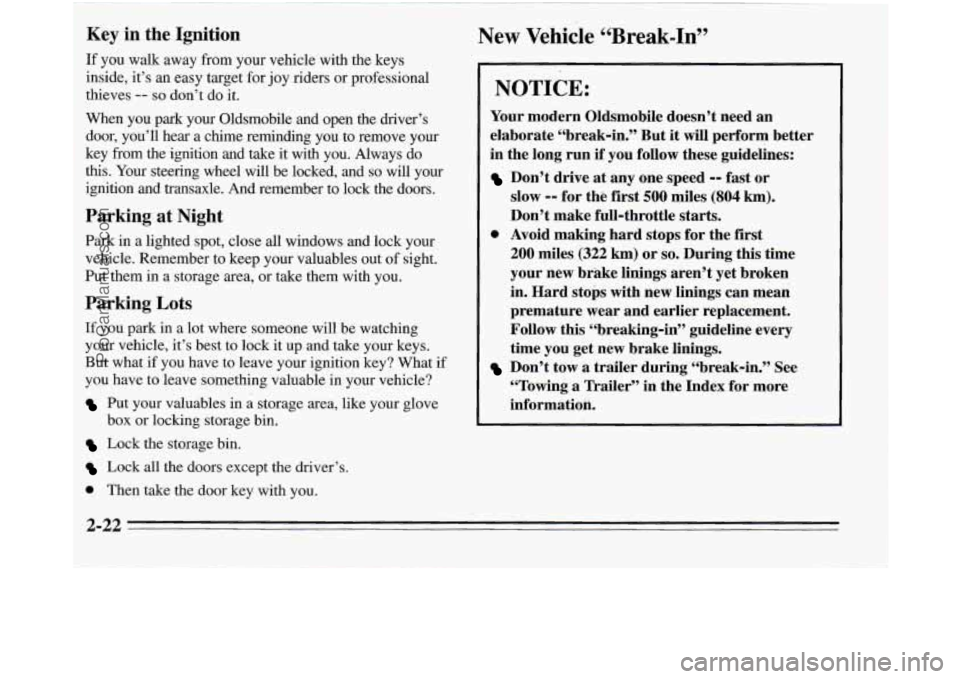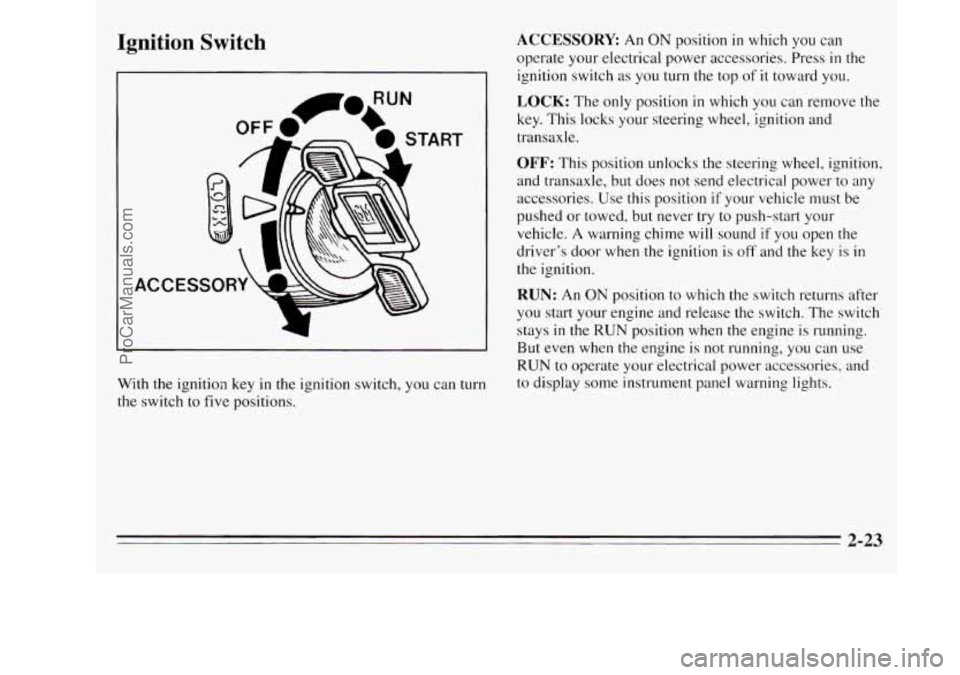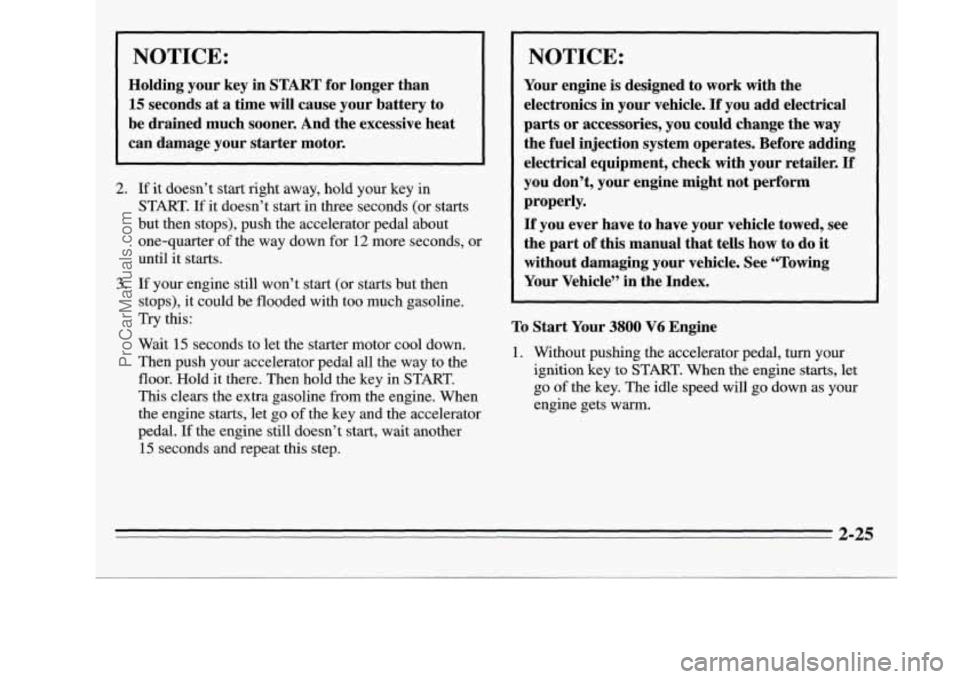tow OLDSMOBILE SILHOUETTE 1995 Owners Manual
[x] Cancel search | Manufacturer: OLDSMOBILE, Model Year: 1995, Model line: SILHOUETTE, Model: OLDSMOBILE SILHOUETTE 1995Pages: 390, PDF Size: 20.27 MB
Page 16 of 390

Dump and Stow Feature
I 3 I
The second and third row bucket seats have been
designed to allow them to fold fully upward and forward
when the seats are anchored in the rear-most position.
This design improves both luggage/cargo capacity and
rear seat entrylexit.
To use this feature on RIGHT ONLY seats: Lift the
upper lever to fold the seatback forward. Push the lower
lever back and tilt the entire seat aqd seatback forward.
To use this feature on CENTER OR LEFT or LEFT
ONLY seats: Lift the upper lever to fold the seatback
forward. Push down on the rear release bar (located
behind the seat), and tilt the entire seat and seatback
forward.
To release the RIGHT ONLY seat from this position:
Push the lower lever back,
while you pull the entire seat
back to the upright position. Lift the upper lever to lift the seatback
up again. Push and pull on t'7e seat and the
seatback to be sure both are locked into
, Isition.
To release the CENTER OR
LEFT or LEFT ONLY seat
from this position: Push the rear release
bar, while you
pull the entire seat back to the upright position. Lift the
upper lever to lift the seatback up again.
Push and pull
on the seat and the seatback to be sure both are locked
into position.
1-6
ProCarManuals.com
Page 18 of 390

Removing Rear Bucket Seats
Removing the RIGHT ONLY Seats
1. Lift the upper lever to fold the seatback forward.
2. Push the lower lever back and tilt the entire seat and
seatback forward.
3. From behind the seat, support the top portion of the
seat with one hand as you squeeze the front release
bar toward the crossbar. The seat will release from
the floor pins.
1-8
ProCarManuals.com
Page 20 of 390

3. From behind the seat, support the top portion of the
seat with one hand
as you squeeze the front release
bar toward the crossbar. The seat will release from
the floor pins.
Adjusting Rear Seats
Each rear seat location has two sets of floor pins. Seats
equipped with the built-in child restraint option must be secured in the rear set of floor pins. Seats that don't have
the built-in child restraint option can be secured in either
set of
floor pins. Move the position of these seats up or
back to provide a little more room behind or in front of a
seat.
1-10
ProCarManuals.com
Page 39 of 390

When should an air bag inflate?
The air bag is designed to inflate in moderate to severe
frontal or near-frontal crashes. The air bag will inflate
only if the impact speed is above the system’s designed
“threshold level.” If your vehicle goes straight into a
wall that doesn’t move or deform, the threshold level is
about
9 to 15 mph (14 to 24 kdh). The threshold level
can vary, however, with specific vehicle design,
so that
it can be somewhat above or below this range. If your
vehicle strikes something that will move
or deform, such
as a parked car, the threshold level will be higher. The
air bag is not designed to inflate
in rollovers, side
impacts, or rear impacts, because inflation would
not
help the occupant.
In any particular crash, no one can say whether an air
bag should have inflated simply because of the damage
to a vehicle or because of what the repair costs were.
Inflation is determined by the angle of the impact and
the vehicle’s deceleration. Vehicle damage is only one
indication of this.
What makes an air bag inflate?
In a frontal or near-frontal impact of sufficient severity,
the air bag sensing system detects that the vehicle
is
suddenly stopping as a result of a crash. The sensing
system triggers a chemical reaction of the sodium azide
sealed in the inflator. The reaction produces nitrogen
gas, which inflates the air bag. The inflator, air bag, and
related hardware are all part of the air bag module
packed inside the steering wheel.
How does an air bag restrain?
In moderate to severe frontal or near-frontal collisions,
even belted occupants can contact the steering wheel.
The air bag supplements the protection provided by
safety belts. Air bags distribute the force
of the impact
more evenly over the occupant’s upper body, stopping
the occupant more gradually. But air bags would not
help you in many types
of collisions, including rollovers
and rear and side impacts, primarily because an
occupant’s m.otion is not toward the air bag. Air bags
should never be regarded as anything more than
a
supplement to safety belts, and then only in moderate to
severe frontal
or near-frontal collisions.
1-29
ProCarManuals.com
Page 65 of 390

@ What if a child is wearing a lap-shoulder belt,
but the
child is so small that the shoulder belt is
very close to the child’s face or neck?
A: Move the child toward the center of the vehicle, but
be sure that the shoulder belt still
is on the child’s
shoulder,
so that in a crash the child’s upper body
would have the restraint that belts provide. If
the
child is so small that the shoulder belt is still very
close to the child’s face or neck, you might want
to
place the child in a seat that has a lap belt, if your
vehicle
has one.
1-55
ProCarManuals.com
Page 81 of 390

1.
2.
3.
4.
5.
Insert a coin into the slot in the back of the
transmitter, and turn it counterclockwise to open the
cover.
Remove the cover.
Remove and replace the 3-volt battery (CR2032).
Reassemble the transmitter. Check the transmitter operation.
Illuminated Entry System (Option)
This option comes with the optional Remote Lock
Control system.
When you open the driver’s door, by itself or in
combination with any passenger door or the liftgate, the
interior lamps will come on and then gradually dim to
off 10 seconds after the last door is closed. (If the
driver’s door has not been opened, the interior lamps
will immediately dim to
off.)
When you press the unlock symbol on your remote
transmitter, the lamps inside your vehicle will
go on,
then gradually dim to
off after about 40 seconds, unless
a door or the liftgate is opened.
When you turn on the ignition, the interior lamps will
immediately dim
to off.
Sliding Door
To open the sliding door from outside the vehicle, pull
the front
of the latch release out and then toward the
rear.
If you slide the door all the way back, it will latch
in the open position.
2-11
ProCarManuals.com
Page 86 of 390

To manually close the power sliding door when the sliding
door enable switch
is in the ON position, pull the inside or
outside latch release or the edge
of the door. Move the door
about four inches toward the closed position and release.
The door will close completely and latch for you.
To manually close the power sliding door when the
enable switch is in the
OFF position, pull the inside or
outside latch release and slide the door all the way
forward
to the latch position.
On vehicles equipped with the optional power sliding
door,
a low voltage battery may cause the system to
become inoperative. This is a built-in feature to prevent
damage to the power sliding door motor.
When the battery has been charged, follow these steps:
1. Make sure the door is in the closed position.
2. Turn the ignition off.
3. Remove the fuse marked TAIL from the fuse panel.
4. Wait 30 seconds.
5. Reinstall the fuse.
6. Cycle the door open and closed with either the wall
mounted
or overhead console switch. Wait three
seconds before opening and closing the door again.
If this does not restore power sliding door operation, see
your retailer for service.
2-16
ProCarManuals.com
Page 92 of 390

Key in the Ignition
If you walk away from your vehicle with the keys
inside, it’s an easy target for joy riders or professional
thieves
-- so don’t do it.
New Vehicle ''Break-in"
When you park your Oldsmobile and open the driver’s
door’ you’ll hear a chime reminding you to remove your
key from the ignition and take it with you. Always
do
this. Your steering wheel will be locked, and so will your
ignition and transaxle. And remember to lock the doors.
Parking at Night
Park in a lighted spot, close all windows and lock your
vehicle. Remember to keep your valuables out
of sight.
Put them in a storage area, or take them with you.
Parking Lots
If you park in a lot where someone will be watching
your vehicle, it’s best to lock it up and take your keys.
But what if you have to leave your ignition key? What if
you have
to leave something valuable in your vehicle?
Put your valuables in a storage area, like your glove
box or locking storage bin.
Lock the storage bin.
Lock all the doors except the driver’s.
0 Then take the door key with you.
NOTICE:
Your modern Oldsmobile doesn’t need an
elaborate “break-in.” But it
will perform better
in the long run if you follow these guidelines:
Don’t drive at any one speed -- fast or
slow
-- for the first 500 miles (804 km).
Don’t make full-throttle starts.
200 miles (322 km) or so. During this time
your new brake linings aren’t yet broken
in. Hard stops with new linings can mean
premature wear and earlier replacement.
Follow this “breaking-in” guideline every
time you get new brake linings.
Don’t tow a trailer during “break-in.” See
“Towing
a Trailer” in the Index for more
information.
0 Avoid making hard stops for the first
2-22
ProCarManuals.com
Page 93 of 390

Ignition Switch
ACCE
With the ignition key in the ignition switch, you can turn
the switch to five positions.
ACCESSORY An ON position in which you can
operate your electrical power accessories. Press
in the
ignition switch
as you turn the top of it toward you.
LOCK: The only position in which you can remove the
key. This locks your steering wheel, ignition and
transaxle.
OFF: This position unlocks the steering wheel, ignition,
and transaxle, but does not send electrical power to any
accessories. Use this position
if your vehicle must be
pushed or towed, but never try
to push-start your
vehicle. A warning chime will sound if
you open the
driver’s door when the ignition is off and the key is in
the ignition.
RUN: An ON position to which the switch returns after
you start your engine and release the switch. The switch
stays in
the RUN position when the engine is running.
But even when the engine is not running, you can use
RUN to operate your electrical power accessories, and
to display some instrument panel warning lights.
2-23
ProCarManuals.com
Page 95 of 390

NOTICE:
Holding your key in START for longer than
15 seconds at a time will cause your battery to
be drained much sooner. And the excessive heat
can damage your starter motor.
2. If it doesn’t start right away, hold your key in
START.
If it doesn’t start in three seconds (or starts
but then stops), push the accelerator pedal about
one-quarter of the way down for
12 more seconds, or
until it starts.
3. If your engine still won’t start (or starts but then
stops), it could
be flooded with too much gasoline.
Try this:
Wait
15 seconds to let the starter motor cool down.
Then push your accelerator pedal all the way to the
floor. Hold it there. Then hold the key in START.
This clears the extra gasoline from the engine. When
the engine starts, let
go of the key and the accelerator
pedal.
If the engine still doesn’t start, wait another
15 seconds and repeat this step.
NOTICE:
Your engine is designed to work with the
electronics in your vehicle.
If you add electrical
parts or accessories, you could change the way
the fuel injection system operates. Before adding
electrical equipment, check with your retailer.
If
you don’t, your engine might not perform
properly.
If you ever have to have your vehicle towed, see
the part of this manual that
tells how to do it
without damaging your vehicle. See “Towing
Your Vehicle” in the Index.
To Start Your 3800 V6 Engine
1. Without pushing the accelerator pedal, turn your
ignition
key to START. When the engine starts, let
go of the key. The idle speed will go down as your
engine gets
warm.
2-25
ProCarManuals.com